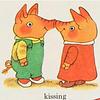You need to sign in or sign up before continuing.
Take a photo of a barcode or cover

digitaldeckle 's review for:
Squire
by Nadia Shammas
3.5, rounded up
Let's get this out of the way first: an incredibly beautiful and heartfelt graphic novel. I do find it frustrating that on here, and in most places online I see this listed as a Nadia Shammas work primarily (plus Sara Alfageeh), this is a huge misunderstanding of how graphic novels work verses a traditional novel (or even picture book). In a GN the images are the text, just as much as the dialogue and script is, what we see of the world and characters is just how they are. Based on the design notes at the back, it seems that most of the characters and world notes are Alfageeh's ideas in origin (in a very collaborative work, mind you) and because of this it really seems remiss to imply the majority of text is from Shammas.
All that being said, there's obviously been a lot of love put into this book. The world feels more realized than most contemporary fantasy, although a surface level realization (more on that in a moment), and in particular I loved that the shading and architecture was explicitly based off of images from Turkey and Jordan. Another standout is the speech bubbles; which have a life and character of their own indicating mood, tone, character background, etc. This is great, and a skill that is so badly missing from the "my first Procreate story" type graphic novels that are popping up everywhere nowadays.
My issue is mostly in how the themes could be deeper or more complex. The "imperialism bad" is an important theme, but not written with any particular depth. This world's empire, which seems to be inspired by the Ottoman and possibly Byzantine empires, but there is not a lot there to what this particular imperial machine thinks and feels. Do they culturally expand because they think they're more civilized than the Urnu people? Is it a difference of religion? They seem to think the Urnu are thieves, but we're not given much explanation how or why.
I do have concerns with the sole black character of the cast. It makes a lot of sense for the characters worlds to be as ethnically diverse as they are (as you saw this in Roman, Persian, Ottoman etc empires). However for the only black character to be characterized as aggressive, cold, and solely focused on fighting... I don't know the optics worry me. There is justification for why that character acts the way he does, but I wonder why (weather implicitly or not) the artist's choice was for the fighter military man to be the only black character and not the soft, and kind archer.
Let's get this out of the way first: an incredibly beautiful and heartfelt graphic novel. I do find it frustrating that on here, and in most places online I see this listed as a Nadia Shammas work primarily (plus Sara Alfageeh), this is a huge misunderstanding of how graphic novels work verses a traditional novel (or even picture book). In a GN the images are the text, just as much as the dialogue and script is, what we see of the world and characters is just how they are. Based on the design notes at the back, it seems that most of the characters and world notes are Alfageeh's ideas in origin (in a very collaborative work, mind you) and because of this it really seems remiss to imply the majority of text is from Shammas.
All that being said, there's obviously been a lot of love put into this book. The world feels more realized than most contemporary fantasy, although a surface level realization (more on that in a moment), and in particular I loved that the shading and architecture was explicitly based off of images from Turkey and Jordan. Another standout is the speech bubbles; which have a life and character of their own indicating mood, tone, character background, etc. This is great, and a skill that is so badly missing from the "my first Procreate story" type graphic novels that are popping up everywhere nowadays.
My issue is mostly in how the themes could be deeper or more complex. The "imperialism bad" is an important theme, but not written with any particular depth. This world's empire, which seems to be inspired by the Ottoman and possibly Byzantine empires, but there is not a lot there to what this particular imperial machine thinks and feels. Do they culturally expand because they think they're more civilized than the Urnu people? Is it a difference of religion? They seem to think the Urnu are thieves, but we're not given much explanation how or why.
I do have concerns with the sole black character of the cast. It makes a lot of sense for the characters worlds to be as ethnically diverse as they are (as you saw this in Roman, Persian, Ottoman etc empires). However for the only black character to be characterized as aggressive, cold, and solely focused on fighting... I don't know the optics worry me. There is justification for why that character acts the way he does, but I wonder why (weather implicitly or not) the artist's choice was for the fighter military man to be the only black character and not the soft, and kind archer.